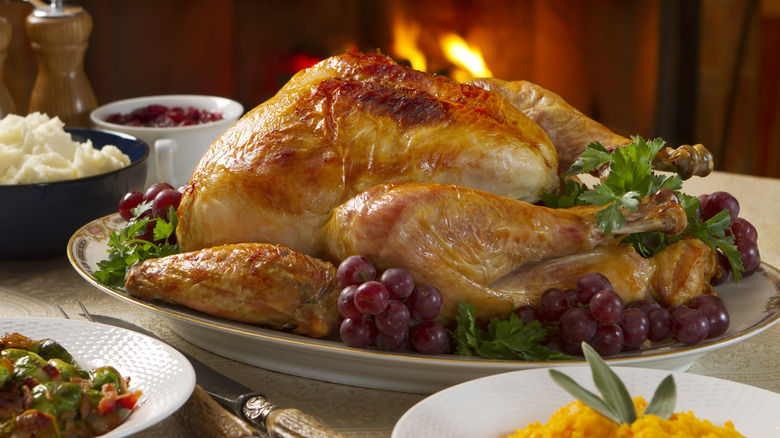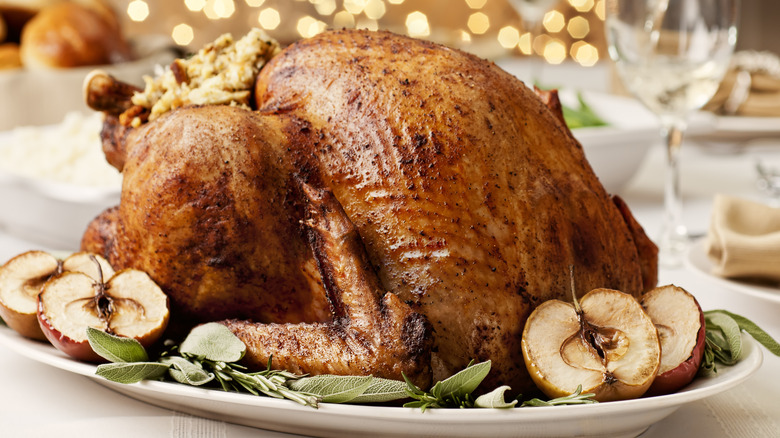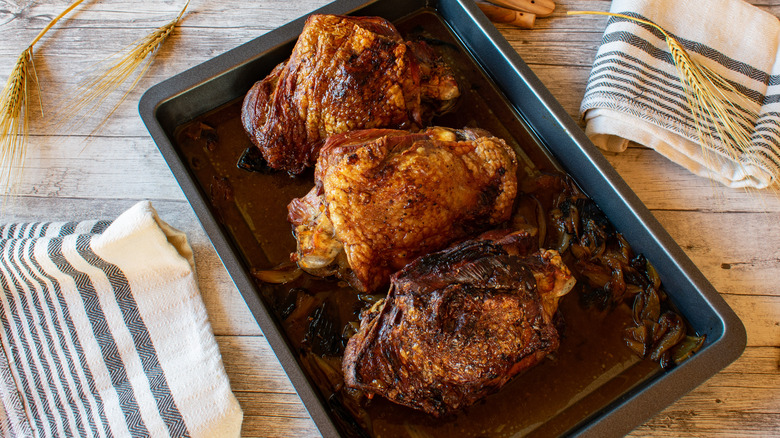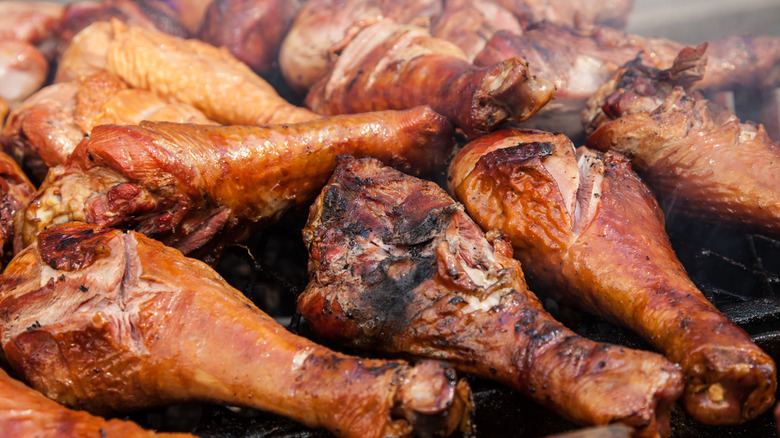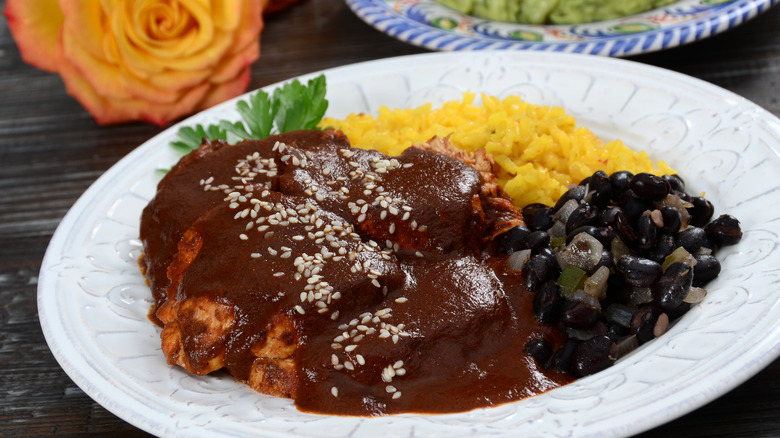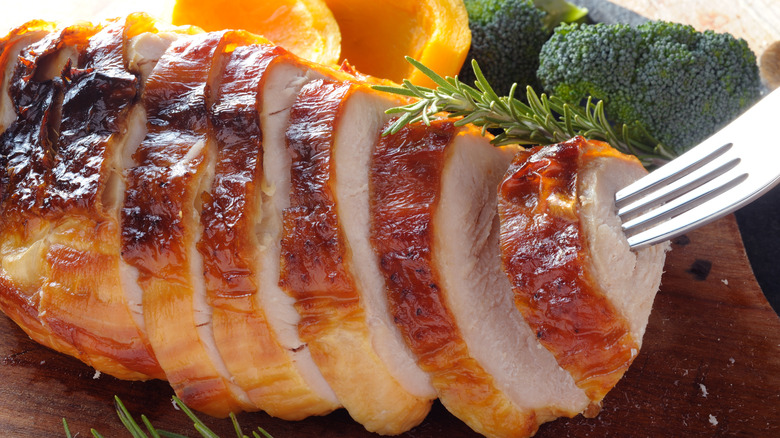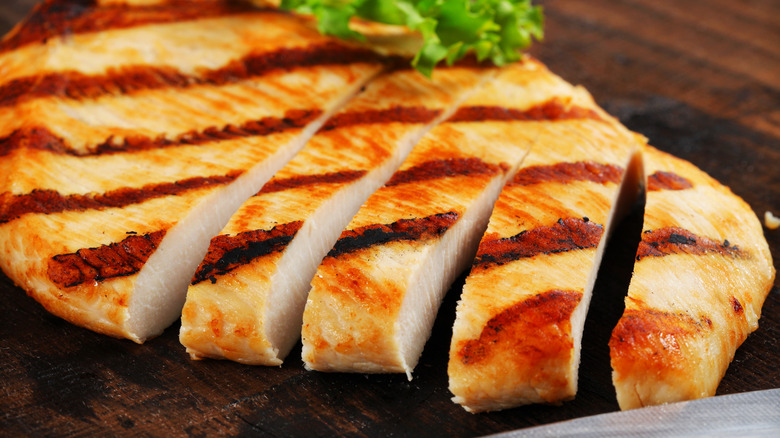White Meat Vs Dark Meat: Which Is Better When It Comes To Turkey?
Every Thanksgiving, once the turkey hits the table, everyone in my family (politely) fights over which parts of the bird they want. Some can't get enough white meat, while others are drumstick and thigh partisans. You might say the choice is down to personal preference. That's a reasonable and tolerant way of looking at it, but I disagree. I think the only acceptable type of turkey to eat is dark meat, and everyone who believes differently is wrong.
Of course, all the people who are content to choke their way through poultry-flavored chalk are just leaving more succulent turkey legs for me to eat, so I'm not particularly upset that a majority of Americans seem to like their turkey blindingly white and bone-dry. Still, the holiday season is all about generosity, so I'm going to share the unassailable reasons why turkey breast is a waste of your time, based on my years of cooking and eating this big bird. If you prefer white meat turkey, consider this an intervention.
Dark meat is almost always juicy
For many of us, Thanksgiving is the only time we're cooking turkey at home, and we're roasting a whole bird. Unless you nail the cooking time or have great luck, the white meat is going to be dry, while the dark meat never fails to be juicy. While every degree you cook the bird over the USDA safety threshold of 165 degrees Fahrenheit saps liquid from the turkey breast, turning it into a poultry desert, the legs and thighs will remain moist and delicious well into the 175-plus degrees Fahrenheit range.
I will admit that I have eaten juicy, tender turkey breast in my life, but hitting the narrow window of perfection requires a miracle when you're cooking at home. Most of the time, roasted turkey white meat has the same saliva-absorbing power as a handful of saltines. Preparing the meat using a wet cooking technique doesn't do much to keep turkey breast moist, either. Braised turkey thighs turn into rich, fatty shreds with a texture reminiscent of pulled pork. Although you can braise and shred turkey breast, the resulting sad protein has the mouthfeel of loose feathers.
Dark meat actually has flavor
The textural deficiencies of white meat would be forgivable if it tasted delicious, but it absolutely does not. White meat turkey is the closest you can get to consuming pure, unflavored amino acids while eating something that technically still qualifies as meat. It does not spark joy, and it does not leave an impression that you'll look back on fondly. It's pure protein, delivered in the least interesting way possible.
Dark meat turkey, on the other hand, shows that there's more to this food than just being a source of nutrients. While turkey breast might as well be blander chicken, you can really taste the distinctive flavor of turkey in the dark meat. It has a gamey undercurrent that's reminiscent of wild birds like pheasants. The mild funkiness of turkey is what sets it apart from the poultry we eat every day, and it's what makes it taste so good with sweet accompaniments like cranberry sauce and sweet potato casserole — the sugary sides mellow out the earthiness of the meat.
If you love turkey skin, dark meat is your friend
We all agree that the skin is the best part of the turkey, right? And though the entire bird is covered in skin, the skin-to-meat ratio on the breast is less than ideal. This is especially true of the Franken-turkeys most of us buy in the grocery store, which have been bred to have super-sized breasts. The thin sheath of skin on the surface of the breast is no match for the vast ocean of bland, dry meat that lurks underneath.
The drumsticks and thighs, on the other hand, have ample enough skin such that you can get some with every bite of meat. Since the skin is where much of the fat (and flavor) of the bird lives, that makes the dark meat even more delicious, which is unfair because it already tastes much better than the white meat, even without skin. The only part of the bird with an even greater amount of skin is the wing, which is technically white meat. However, unlike chicken wings, I find that turkey wings almost always dry out when cooking, so they don't tend to be super tasty. I prefer using them to make stock rather than trying to gnaw at them at the table.
Dark meat can be used in a wider variety of recipes
For our money, the only good ways to cook white meat turkey are ones that use gentle, low heat to preserve the small amount of water that is present in the breast. Poaching can work, as can low-and-slow barbecuing — as an added bonus, the smoke flavor from barbecuing helps give turkey breast some personality. Turkey breast also makes decent deli meat because meat producers tend to pump it full of water and salt to give it flavor and moisture.
In contrast, dark meat turkey can be used for all these applications, plus so many more. Sure, smoked turkey breast is good, but it doesn't hold a candle to Disney-style smoked turkey legs. The same cut can also be roasted to make Cajun-spiced turkey legs. Turkey thigh is also a seriously underrated cut if you can get a hold of it. It does well on the grill, and as we referenced earlier, it's the absolute best piece of turkey to slow-cook or braise. I love it for making tinga for turkey tacos; it tastes great with mole sauce, and it's perfect for soups as well.
White meat isn't actually healthier
At this point in the article, you may be thinking, "Yes, I know white meat is trash compared to dark meat from a culinary perspective. But I eat white meat because it's healthier, not because I like it more." First off, if that's your reasoning during Thanksgiving, I don't understand you. The holiday is about cramming 3,000 calories into your body as quickly as possible; it's not a time to be making healthy decisions.
But even if you make turkey a regular part of your diet outside of the holiday season, the "white meat is better for you" argument doesn't really hold up. While, yes, dark meat is slightly higher in overall fat, saturated fat, and calories than white meat, it has nutritional benefits that outweigh those mild negatives. Per Houston Methodist clinical dietitian Emma Willingham, dark meat is "packed with micronutrients that play important roles in the metabolism of protein, carbs and fat. Overall, white meat is actually less nutrient dense than dark meat."
Dark meat is chock-full of iron and is rich in heart-healthy unsaturated fat. Really, if you want to be as healthy as possible when eating turkey, the one thing to avoid is the skin. This is sad, as the skin is so delicious, but it's the area of the bird with the greatest concentration of saturated fat and cholesterol.
White meat is more expensive
Even with all the negatives I've highlighted, I might consider eating white meat turkey if it were significantly cheaper than dark meat, but actually, the opposite is true. If you buy turkey sections rather than a whole bird, the dark meat will likely be at least a little bit cheaper. For example, at my local Sprouts, I can buy turkey drumsticks for essentially half the price per pound of turkey breast tenders.
The reason for the price discrepancy is that, for some reason, white meat is more popular than dark meat in the U.S. If you're a dark meat connoisseur like me, you can take advantage of the American public's bad taste in poultry by scoring great deals on the choicest cuts. America's turkey producers would certainly love it if you started buying more dark meat turkey — they've historically had a hard time selling legs and thighs in America, reserving these tasty morsels for the export market.
